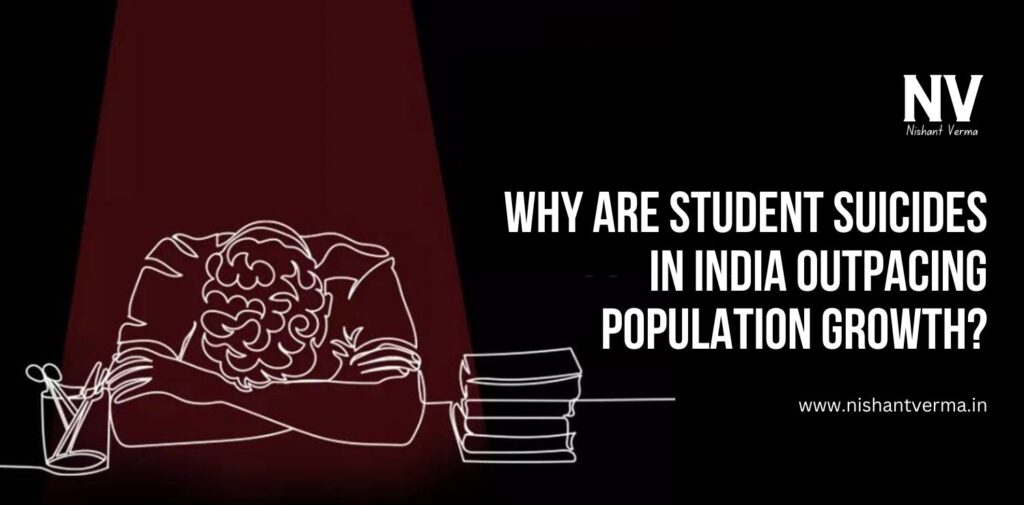In recent years, a disturbing trend has emerged in India: student suicides are increasing at an alarming rate, surpassing even the country’s population growth. This unsettling reality raises several critical questions: What is driving this tragic rise? What factors are contributing to the immense pressure students face? And most importantly, what can be done to address this crisis?
Statistics and Trends: Student Suicides in India
India is home to one of the largest youth populations in the world, with nearly half of its 1.4 billion people under the age of 25. This demographic has long been seen as a potential engine of growth, with millions of young people pursuing education in hopes of bettering their lives and contributing to the nation’s development. However, the pressures that come with this pursuit have led to a crisis of mental health, particularly among students.

According to the National Crime Records Bureau (NCRB), the number of student suicides in India has been steadily rising over the past decade. In 2021, over 13,000 students took their own lives, marking a grim milestone where the rate of student suicides outpaced the country’s population growth rate. While India’s population continues to grow at around 1% annually, the rate of student suicides has surged far beyond this, highlighting a deep-rooted issue in the education system and society at large.
The Root Causes: What’s Driving Students to the Brink?
To understand why student suicides are rising so rapidly, it’s essential to explore the myriad pressures faced by students in India. The following factors contribute significantly to this alarming trend:

Academic Pressure: Academic success in India is often equated with personal worth and future security. From a young age, students are pushed to excel in highly competitive environments. The pressure to secure top grades, gain admission to prestigious institutions, and succeed in a narrow definition of success creates a relentless burden. The education system, heavily reliant on rote learning and standardized testing, leaves little room for creativity, critical thinking, or personal growth.
Parental Expectations: Many Indian parents hold high expectations for their children, often envisioning careers in engineering, medicine, or other traditionally esteemed professions. While parental aspirations are well-intentioned, they can inadvertently place immense stress on students. The fear of disappointing their families can lead to severe anxiety and depression, particularly when students struggle to meet these expectations.
Social Stigma and Mental Health: Mental health issues, such as anxiety and depression, are often stigmatized in Indian society. Students struggling with these challenges may feel isolated, ashamed, or fearful of seeking help. The lack of awareness and understanding surrounding mental health exacerbates the problem, as students are left to cope with their struggles in silence. Furthermore, the limited availability of mental health resources in schools and universities means that many students do not receive the support they need.
Competitive Culture: The Indian education system fosters a highly competitive environment where students are often pitted against each other. The intense focus on rankings, marks, and cut-off percentages can lead to a sense of inadequacy among students who feel they do not measure up. This culture of competition extends beyond academics, affecting students’ social lives and self-esteem.

Societal Pressure and Comparison:Society at large plays a significant role in shaping students’ self-worth. Social media and other platforms can exacerbate feelings of inadequacy as students compare themselves to their peers. The constant pressure to “keep up” with others, whether in terms of academic achievement, physical appearance, or social status, can lead to overwhelming stress and anxiety.
Lack of Counseling and Support Systems:Indian educational institutions often lack adequate counseling services and mental health support. Many schools and colleges do not have trained counselors on staff, and those that do may be under-resourced and unable to meet the needs of all students. This absence of support leaves students without a safe space to discuss their concerns or seek guidance, increasing the risk of mental health crises.
The Fallout: Impact on Students and Society
The rising rate of student suicides has profound implications for both the individuals affected and society as a whole. On a personal level, the loss of young lives to suicide is a tragedy that leaves families and communities devastated. The psychological and emotional toll on parents, siblings, and friends is immeasurable.
From a societal perspective, the increase in student suicides reflects broader issues within the education system and social structure. It highlights the urgent need for reform in how education is approached and how mental health is addressed. The current system, which prioritizes academic achievement above all else, is failing to nurture well-rounded, resilient individuals. Moreover, the stigma surrounding mental health continues to hinder progress, preventing students from seeking help when they need it most.
What Can Be Done? Solutions and Strategies
Addressing the crisis of student suicides in India requires a multifaceted approach that involves educational reform, increased mental health support, and cultural change. The following strategies could help mitigate the factors contributing to this epidemic:
Educational Reform:
- Holistic Education: Shift the focus from rote learning and standardized testing to a more holistic approach that values creativity, critical thinking, and emotional intelligence. Curriculum changes should promote the development of well-rounded individuals rather than just academically successful ones.
- Reduced Emphasis on Exams: Reducing the high-stakes nature of exams and broadening the criteria for academic success can help alleviate some of the pressure students face. Continuous assessment methods and alternative pathways to higher education should be explored.
Parental and Societal Awareness:
- Parental Education: Parents need to be educated about the dangers of excessive pressure and the importance of supporting their children’s mental health. Parenting programs and workshops can help parents develop healthier expectations and communication strategies.
- Social Awareness Campaigns: Public campaigns aimed at reducing the stigma surrounding mental health can encourage more open discussions and help-seeking behavior. These campaigns should target students, parents, and educators alike.

Enhanced Mental Health Support:
- School and College Counseling: Every educational institution should have access to trained mental health professionals. Regular counseling sessions should be available to all students, and efforts should be made to create a supportive environment where mental health is prioritized.
- Mental Health Curriculum: Incorporating mental health education into the school curriculum can equip students with the tools they need to manage stress, recognize the signs of mental health issues, and seek help when necessary.
Creating a Supportive Environment:
- Peer Support Programs: Establishing peer support networks can provide students with a sense of community and belonging. Peer counselors, who are trained to listen and offer support, can play a vital role in identifying and assisting students in need.
- Safe Spaces: Schools and colleges should create safe spaces where students can unwind, relax, and express themselves without fear of judgment. These spaces can include relaxation rooms, student clubs, and open forums for discussion.
Government and Policy Interventions:
- Policy Reforms: The government should implement policies that address the mental health needs of students. This includes funding for mental health services in schools, setting up helplines, and ensuring that educational policies do not exacerbate stress levels.
- Research and Data Collection: Continuous research into the causes of student suicides and the effectiveness of intervention strategies is crucial. Data-driven approaches can help identify trends, at-risk groups, and areas where resources should be allocated.
Looking Ahead: A Call for Change
The rise in student suicides in India is a wake-up call for society to reevaluate its priorities and approach to education. It is a stark reminder that academic success should not come at the cost of mental well-being. The solutions to this crisis are within reach, but they require collective action from educators, parents, policymakers, and society at large.
Addressing the root causes of student suicides in India is not just about preventing deaths; it’s about creating an environment where every student can thrive, both academically and personally. It’s about recognizing that mental health is as important as physical health, and that a student’s worth is not solely determined by their academic achievements.
The time for change is now. If we want to secure the future of our youth and, by extension, the future of our nation, we must act decisively to protect the mental well-being of our students. Only then can we ensure that every young person has the opportunity to lead a fulfilling, successful, and happy life.




